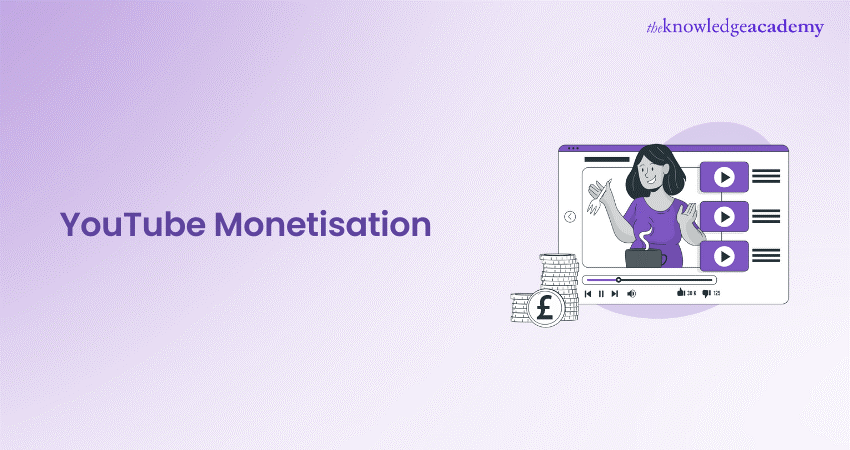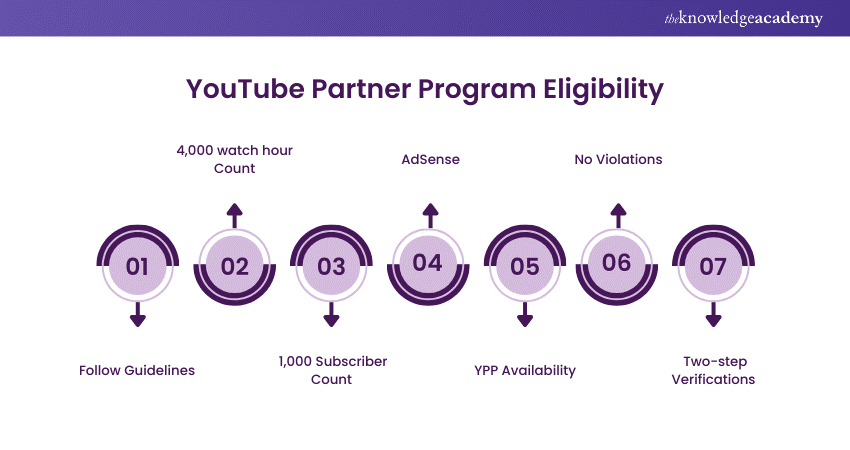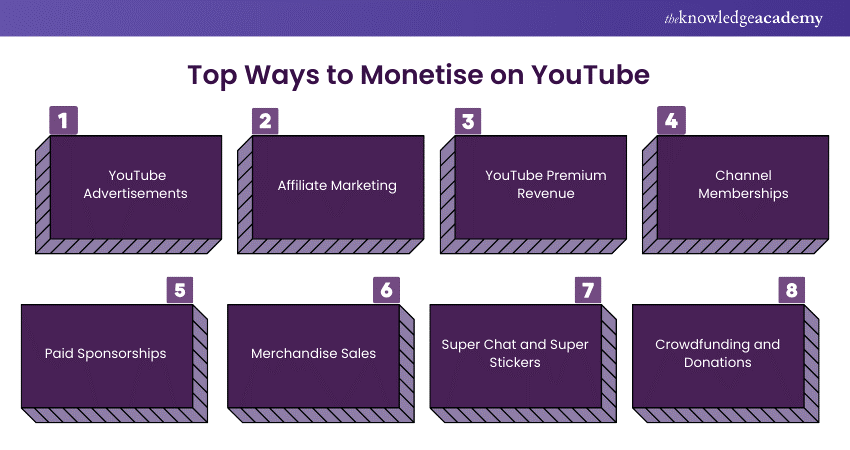We may not have the course you’re looking for. If you enquire or give us a call on +91-181-5047001 and speak to our training experts, we may still be able to help with your training requirements.
Training Outcomes Within Your Budget!
We ensure quality, budget-alignment, and timely delivery by our expert instructors.

Can you turn your passion for creating videos into a business? Absolutely! You can transform your passion for creating videos into a thriving business. YouTube has evolved significantly, now providing countless opportunities for content creators. Whether you're a vlogger, educator, or hobbyist, you can start your channel and turn it into a profitable venture. This blog will unveil all the strategies you need to succeed with YouTube Monetisation. Let's dive in and start earning from your videos!
Table of Content s
1) What is YouTube Monetisation?
2) YouTube's Updated Monetisation Criteria
3) Six Rules of YouTube Monetisation
4) Top Ways to Monetise on YouTube
5) Conclusion
What is YouTube Monetisation?
YouTube Monetisation is the process of earning money from your YouTube videos. It primarily involves generating revenue through advertisements displayed on your videos via Google AdSense.
Additionally, content creators can earn through channel memberships, where subscribers pay a monthly fee for exclusive perks, and Super Chat, where viewers pay to have their messages highlighted during live streams.
By leveraging these monetisation methods, creators can turn their YouTube channels into profitable ventures. If you also want to start your monetisation journey, you have come to the right page!
YouTube's Updated Monetisation Criteria
The YouTube Partner Programme (YPP) enables content creators to access special features that benefit from YouTube monetisation. To be eligible, you must meet these criteria:
a) Follow YouTube's Monetisation Policies: To meet community standards, YouTubers must adhere to its guidelines and policies.
b) Watch Hours: Creators must have 4,000 watch hours on their videos within the last 12 months to showcase viewership and engagement.
c) Subscriber Count: At least 1,000 subscribers are a must because subscribers talk about engagement and dedication from the audience side.
d) Linked AdSense Account: Creators must link their channel to AdSense to earn money from the ads displayed in their videos.
e) Geographical Location: To be a part of YPP, you need to specify your geographical location.
f) No Community Guidelines Strikes: Your channel must sustain a clean record without any violation or breaches.
g) Two-Step Verification: To add a security layer, apply two-step verification to your Gmail account, which links to your channel.
Unlock your potential with our YouTube Marketing Course today!
Six Rules of YouTube Monetisation
Monetisation is not just posting videos but also a strategic approach to maximise your earning potential. Let’s explore the six rules of YouTube monetisation:
1) Set Up an AdSense Account
Begin by setting up an AdSense account, as it is essential for earning income from advertisements. AdSense, a Google advertising platform, helps in selling and displaying ads, including on YouTube. After setting up your account, make sure it is completely verified and adheres to AdSense rules. Link this account to your YouTube channel to start earning money from your content.
2) Understand YouTube Partner Programme Eligibility
Afterwards, I will become a YouTube Partner Programme (YPP) member to unlock monetisation tools such as the merchandise shelf and channel memberships. To be eligible, you need to:

a) Adhere to YouTube’s Guidelines: YouTube has specific community guidelines and policies that all creators must follow. This includes ensuring that your content is family-friendly, doesn’t promote harmful activities, and respects intellectual property rights. Regularly reviewing YouTube’s guidelines helps you stay updated on any changes that might affect your eligibility.
b) Accumulate 4,000 Watch Hours: You need at least 4,000 watch hours on your channel’s videos over the past 12 months. This metric demonstrates that your content engages viewers effectively. You can track your watch hours in YouTube Analytics, which shows detailed insights into viewer behaviour and video performance.
c) Gain 1,000 Subscribers: Your channel must have at least 1,000 subscribers. This number reflects your audience’s dedication and engagement with your content. Building a subscriber base involves creating high-quality content, engaging with viewers, and promoting your channel across various platforms.
d) Link an AdSense Account: To earn money from ads, you must link your YouTube channel to an AdSense account. AdSense is Google’s advertising platform that handles ad placements and payments. Ensure your AdSense account is active and in good standing to receive revenue from ads displayed on your videos.
e) Ensure YPP Availability in Your Region: The YouTube Partner Programme is not available in every country. You must reside in a region where YPP is accessible. YouTube provides a list of eligible countries and regions on its website, which can help you confirm if you qualify based on your location.
f) Maintain a Clean Record with No Community Guidelines Strikes: Your channel must be free of community guidelines strikes. Violations of YouTube’s rules can lead to content removals, strikes, and even channel suspensions. To avoid strikes, adhere strictly to YouTube’s content policies and resolve any issues promptly if they arise.
g) Enable Two-Step Verification: Two-step verification adds an extra layer of security to your Google account. By enabling this feature, you help protect your YouTube channel from unauthorized access. Google offers various methods for two-step verification, such as using an authentication app or receiving text messages.
By meeting these criteria and maintaining compliance with YouTube’s guidelines, you can unlock monetisation tools and start generating revenue from your YouTube channel. Keep your channel engaging and adhere to the rules to sustain your eligibility and maximise your earning potential.
3) Activate Monetisation on YouTube
After being approved for the YPP, head to YouTube Studio and click on "Enable Monetisation." Then, follow the prompts on the screen to start earning money from your channel.
4) Adhere to YouTube's Monetisation Policies
It is crucial to comply with YouTube's extensive guidelines. This will remove all the chances of getting banned or suspended by YouTube later. Some examples are:
a) Google Adsense Guidelines and Policies: Google AdSense mandates compliance with content rules to guarantee appropriate ad placement on websites. Violations including endorsing banned content, may result in your account being suspended or terminated.
b) Community Guidelines: Community guidelines establish appropriate conduct and content on platforms, encouraging a secure and respectful atmosphere. Not following these guidelines may lead to content being taken down, receiving account alerts, or facing permanent bans.
c) Copyright Laws Govern the Protection of Intellectual Property: Copyright laws safeguard creators' intellectual property rights by preventing unapproved use of their work. Infractions may result in legal consequences, such as penalties and deletion of content.
d) YouTube's Terms of Service: YouTube's Terms of Service detail regulations for utilising the platform, encompassing content guidelines and user duties. Failure to comply can lead to consequences such as content strikes, channel demonetisation, or account termination.
5) Comply with Copyright Regulations
To prevent infractions, use authorised music and other copyrighted materials. Consider platforms such as Lickd for legally incorporating music into your videos.
6) Common Pitfalls to Avoid for Effective YouTube Monetisation
Avoid common pitfalls to gain advertiser's trust:
1) Avoid Misleading Statements: Avoid making controversial, misleading, or untrue statements to prevent harming your credibility and violating platform guidelines.
2) Limit Offensive Language: Using offensive language too frequently can drive away viewers and result in content restrictions or demonetisation.
3) Use Honest Thumbnails: Misleading image previews can lead to viewer distrust and possible platform penalties for violating content policies.
4) Avoid Excessive Shock Content: Content that is excessively shocking without proper context may be reported as inappropriate. It could impact the reputation of your channel and its compliance with platform regulations.
Boost your marketing skills with our Digital Marketing Course – Register now!
Top Ways to Monetise on YouTube
Let’s explore some of the top ways to monetise your YouTube channel to maximise your earning potential:

1) YouTube Advertisements
YouTube Ads serve as a main source of revenue for content creators. It usually pops up prior to, in the middle of, or following videos. You have the option of selecting different types of ad formats, like skippable, non-skippable, or bumper ads, to tailor them to your content and audience, maximising revenue through strategic placement.
2) Affiliate Marketing
Participating in affiliate marketing means sharing links to a company's products or services. By incorporating these hyperlinks in your video descriptions or content, you can earn a commission on purchases made through your referrals, offering a profitable means to monetise your impact.
3) YouTube Premium Revenue
YouTube Premium provides subscribers with ad-free viewing and additional perks. As a creator, you can receive a portion of the subscription fee determined by the amount of time Premium members spend watching your channel, offering a separate source of income apart from ad views.
4) Channel Memberships
Fans can sign up for channel memberships monthly to gain access to exclusive benefits like personalised badges, special videos. Users can also participate in live chats as well. This characteristic aids in developing a faithful group of individuals and provides a consistent source of revenue from regular payments.
5) Paid Sponsorships
Paid sponsorships consist of collaborations with businesses and brands, in which you present their products or services in your videos. This partnership could serve as a substantial revenue stream, enabling you to make money by endorsing pertinent and valuable products to your followers.
6) Merchandise Sales
Monetising your brand and involving fans can be achieved by selling items such as T-shirts, mugs, or personalised products. Including these products in your videos or sharing links to your e-commerce site can increase sales and enhance your relationship with your audience.
7) Super Chat and Super Stickers
Super Chat and Super Stickers allow viewers to purchase highlighted messages or animated stickers while watching live streams. This direct engagement not only increases audience involvement but also acts as an extra source of income.
8) Crowdfunding and Donations
Platforms such as Patreon or Buy Me a Coffee enable your audience to provide support through donations or subscriptions. This approach allows supporters to contribute directly to your creative projects, typically in return for exclusive content or incentives. Thus, building a supportive community.
Conclusion
We hope you’ve understood YouTube Monetisation criteria and ways to earn some passive income. Since YouTube offers a wealth of opportunities, anyone can participate in the Programme and earn via ads, memberships, and YouTube Premium. However, you need to stay up to date with trends to adhere to YouTube guidelines and policies.
Elevate your brand with our Social Media Marketing Course- Sign up now!
Frequently Asked Questions

To become a YouTube partner and begin earning money, you must have accumulated 1,000 subscribers and 4,000 watch hours within the past year. Furthermore, you must adhere to all of YouTube's monetisation regulations to qualify.

Certainly, it is possible to generate revenue from live videos on YouTube by utilising features like Super Chat, Super Thanks, Super Stickers, and other monetisation tools. These characteristics enable viewers to donate directly while watching live broadcasts, creating an extra source of income apart from regular advertisements.

Generally, YouTube issues payments on the 21st day of each month. Nonetheless, you are required to achieve a minimum threshold of 77.90GBP in your AdSense account. If your payment method is not established or your earnings fall below the threshold, payments may be postponed.

The Knowledge Academy takes global learning to new heights, offering over 30,000 online courses across 490+ locations in 220 countries. This expansive reach ensures accessibility and convenience for learners worldwide.
Alongside our diverse Online Course Catalogue, encompassing 17 major categories, we go the extra mile by providing a plethora of free educational Online Resources like News updates, Blogs, videos, webinars, and interview questions. Tailoring learning experiences further, professionals can maximise value with customisable Course Bundles of TKA.

The Knowledge Academy’s Knowledge Pass, a prepaid voucher, adds another layer of flexibility, allowing course bookings over a 12-month period. Join us on a journey where education knows no bounds.

The Knowledge Academy offers various Digital Marketing Courses, including the Digital Marketing Course, YouTube Marketing Course, and Google AdSense Course. These courses cater to different skill levels and provide comprehensive insights into How To Make Money on YouTube
Our Digital Marketing Blogs cover a range of topics related to Digital Marketing, offering valuable resources, best practices, and industry insights. Whether you are a beginner or looking to advance your Digital Marketing skills, The Knowledge Academy's diverse courses and informative blogs have got you covered.
Upcoming Digital Marketing Resources Batches & Dates
Date
 Youtube Marketing Course
Youtube Marketing Course
Fri 21st Feb 2025
Fri 25th Apr 2025
Fri 20th Jun 2025
Fri 22nd Aug 2025
Fri 17th Oct 2025
Fri 19th Dec 2025







 Top Rated Course
Top Rated Course



 If you wish to make any changes to your course, please
If you wish to make any changes to your course, please


